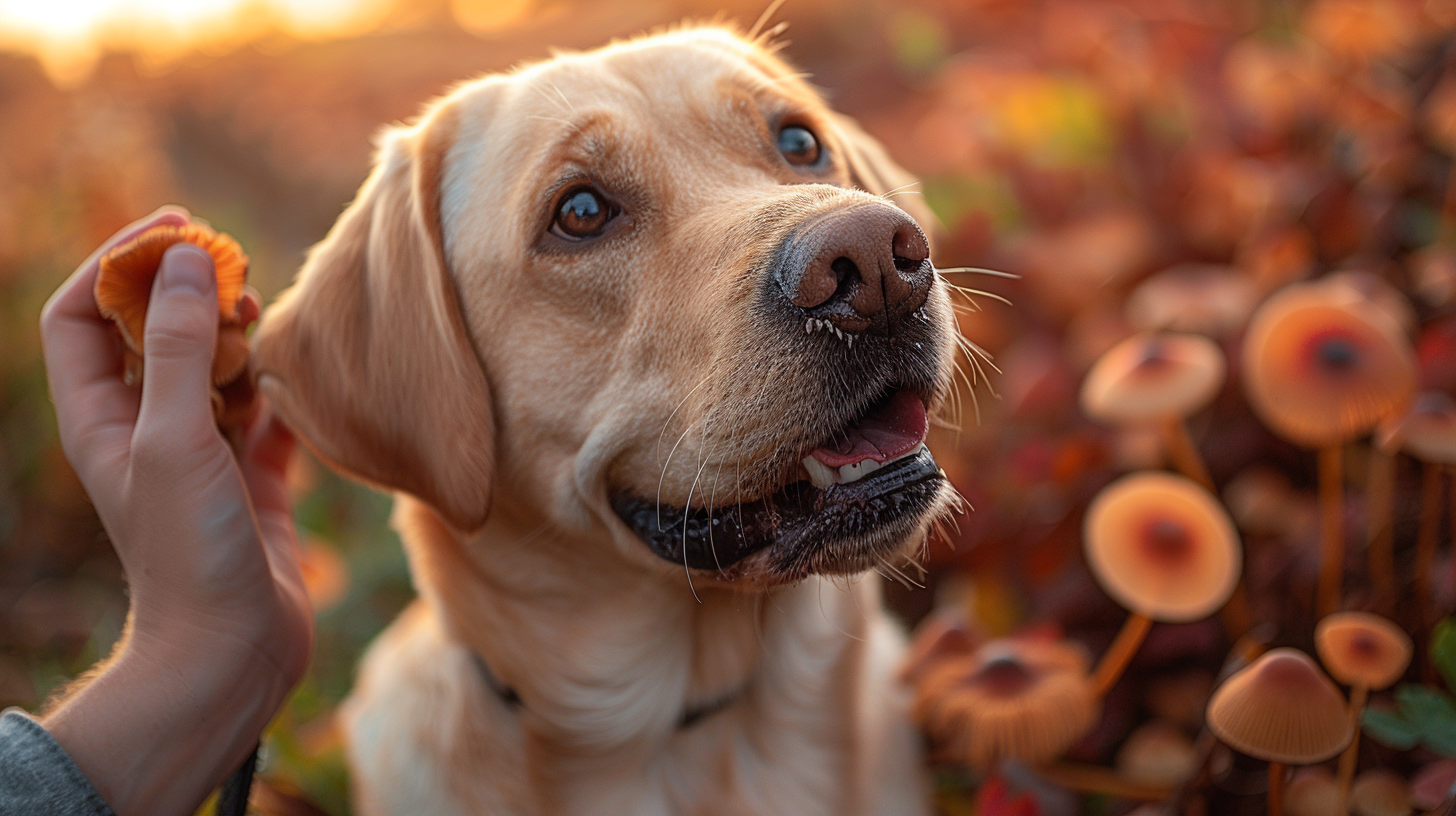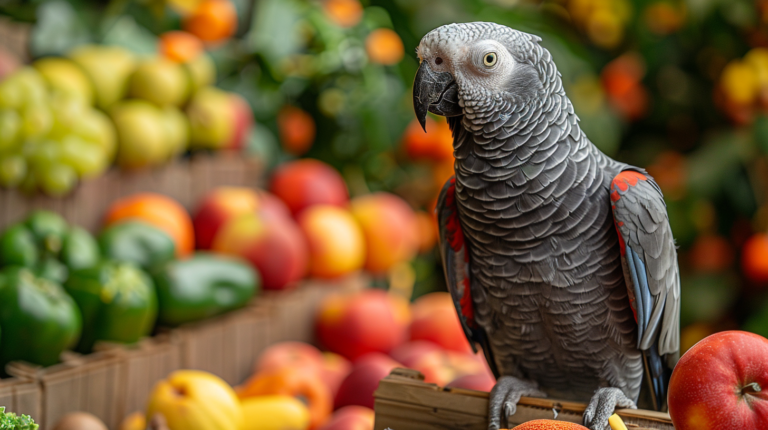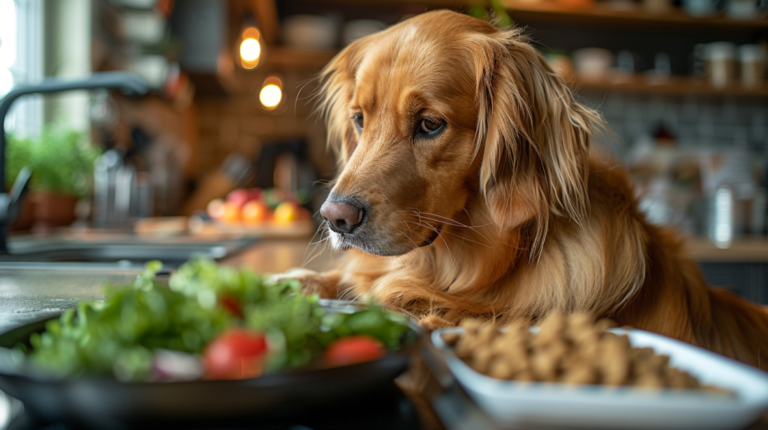Can dogs have mushrooms? Learn about 4 deadly poisonous mushroom types, safe varieties, symptoms of toxicity, and emergency steps to protect your pet’s health.
Table of Contents
While some mushrooms are perfectly safe for dogs to consume, others can be deadly within hours of ingestion. According to the Pet Poison Helpline, mushroom poisoning accounts for approximately 7% of all plant-related toxicity cases in dogs, with wild mushrooms being responsible for the majority of severe poisoning incidents. Understanding which mushrooms pose a threat and how to respond in emergency situations is crucial knowledge every dog owner should possess.
In this comprehensive guide, we’ll explore everything you need to know about dogs and mushrooms, including the four most dangerous poisonous varieties, safe mushroom options, symptoms to watch for, and immediate steps to take if your dog consumes a potentially toxic mushroom. Let’s dive into this critical pet safety topic that could make the difference between life and death for your beloved companion.
Understanding Mushroom Toxicity in Dogs
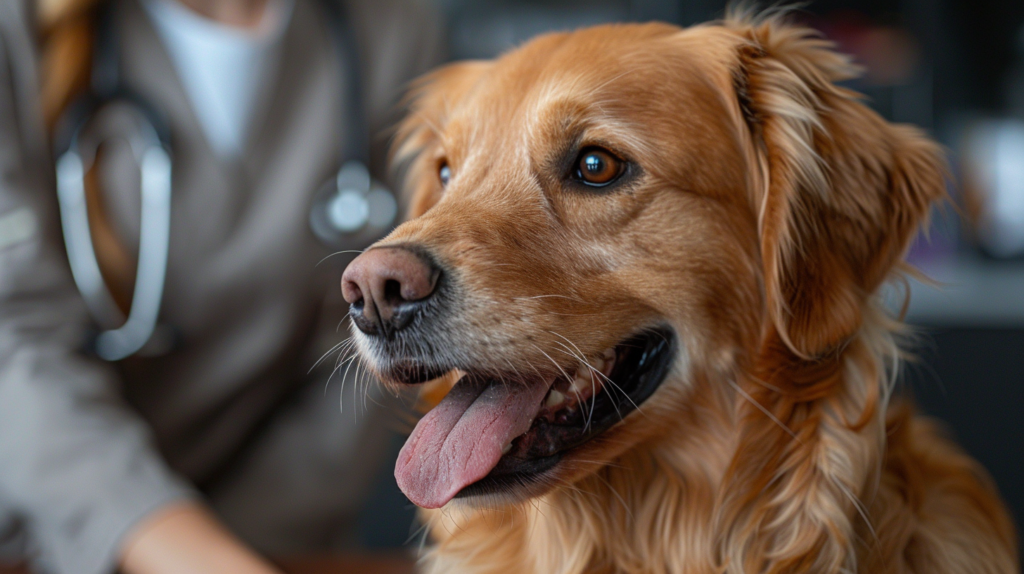
Mushroom toxicity in dogs occurs when canines consume fungi containing harmful compounds called mycotoxins. These natural toxins serve as the mushroom’s defense mechanism against predators, but they can wreak havoc on a dog’s digestive, nervous, and circulatory systems.
Unlike humans, dogs lack the evolutionary ability to distinguish between safe and poisonous mushrooms instinctively. Their curious nature and tendency to explore the world through taste make them particularly vulnerable to mushroom poisoning. Dr. Sarah Johnson, a veterinary toxicologist at the ASPCA Animal Poison Control Center, notes, “Dogs are indiscriminate eaters, and they’re often attracted to the earthy smell and texture of mushrooms, regardless of their toxicity level.”
How Mushroom Poisoning Affects Dogs
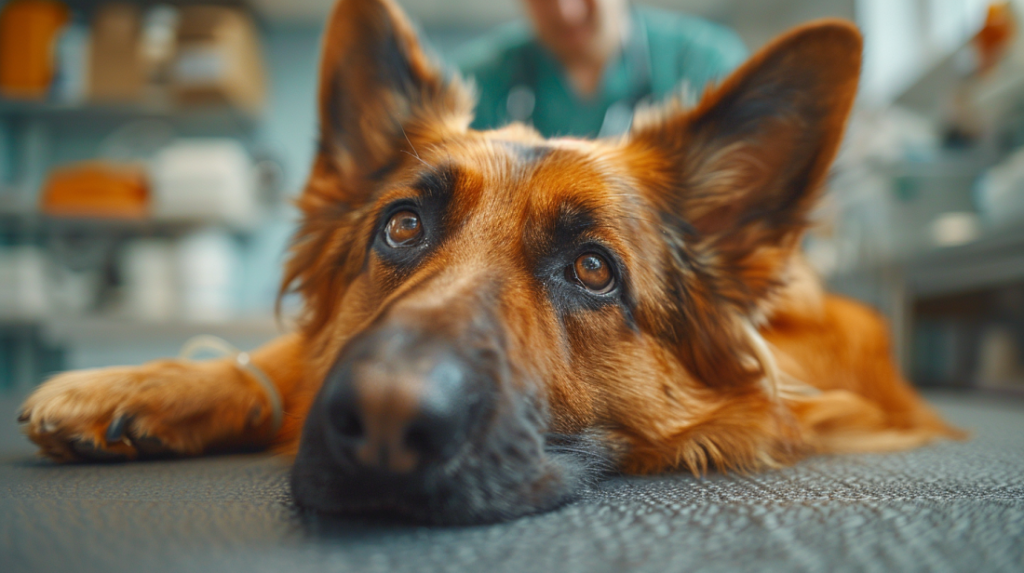
When a dog consumes a toxic mushroom, the mycotoxins are rapidly absorbed through the digestive tract and distributed throughout the body. The severity of poisoning depends on several factors:
- Type of mushroom consumed
- Amount ingested relative to body weight
- Time elapsed since consumption
- Individual dog’s sensitivity and health status
- Age and size of the dog
The most dangerous mushroom toxins target vital organs, particularly the liver, kidneys, and central nervous system. Some species contain multiple types of toxins, creating a complex poisoning scenario that requires immediate veterinary intervention.
The 4 Most Poisonous Mushroom Types for Dogs
1. Death Cap Mushrooms (Amanita phalloides)

Death cap mushrooms earn their ominous name through their lethal reputation. These innocuous-looking fungi are responsible for approximately 90% of all mushroom-related deaths in both humans and animals worldwide. Found primarily in wooded areas with oak, pine, and chestnut trees, death caps have expanded their range across North America over the past several decades.
Key Identifying Features:
- Cap: 2-6 inches wide, initially dome-shaped, later flattening
- Color: Variable from white to pale green to brownish
- Stem: White with a distinctive bulbous base
- Gills: White and closely spaced
- Ring: Prominent white ring around the upper stem
Toxins Present: Death caps contain three primary toxin groups: amatoxins, phallotoxins, and virotoxins. Amatoxins are the most deadly, causing irreversible liver and kidney damage. As little as 30 grams of fresh death cap mushroom can be fatal to a 20-pound dog.
Symptoms and Timeline:
- 6-12 hours post-ingestion: Severe vomiting, diarrhea, abdominal pain
- 12-24 hours: Temporary improvement (false recovery period)
- 24-72 hours: Liver failure, kidney dysfunction, seizures, coma
2. Destroying Angels (Amanita bisporigera, A. ocreata, A. virosa)

Destroying angels are pure white mushrooms that appear deceptively beautiful and harmless. These deadly fungi contain the same amatoxins found in death caps, making them equally dangerous to dogs. They typically grow in wooded areas, particularly around hardwood trees, during late summer and fall.
Key Identifying Features:
- Cap: 2-4 inches wide, pure white, bell-shaped when young
- Stem: White, tall (4-6 inches), with bulbous base
- Gills: White and free from the stem
- Ring: White, persistent ring on upper stem
- Overall appearance: Entirely white
Unique Dangers: Destroying angels are particularly treacherous because their pristine white appearance can fool people into thinking they’re safe, edible varieties. The delayed onset of symptoms (6-12 hours) means that by the time clinical signs appear, significant organ damage has already occurred.
3. Fly Agaric (Amanita muscaria)
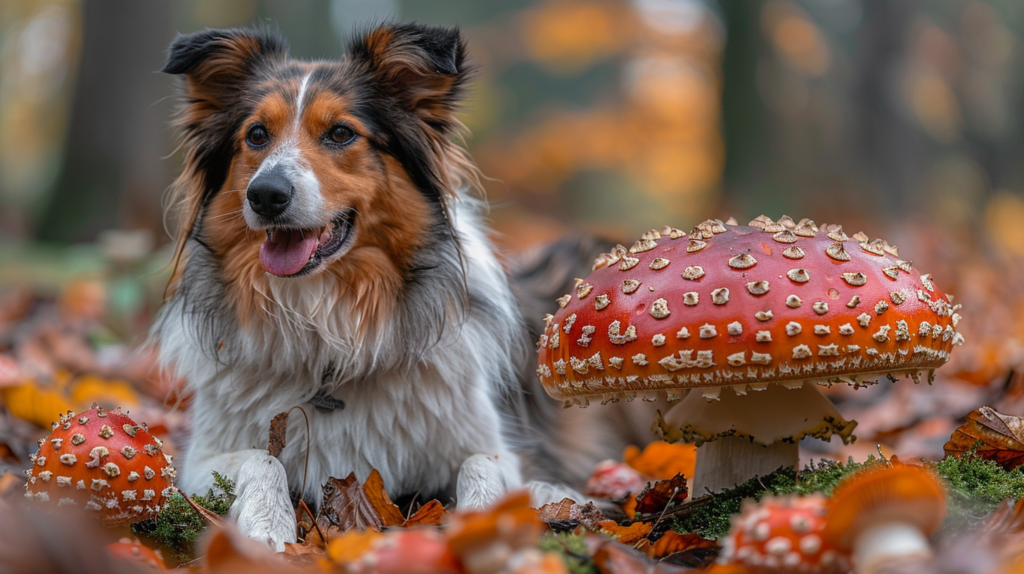
The iconic red and white spotted fly agaric is perhaps the most recognizable mushroom in popular culture, frequently depicted in fairy tales and folklore. Despite their whimsical appearance, these mushrooms contain dangerous psychoactive compounds that can cause severe neurological symptoms in dogs.
Key Identifying Features:
- Cap: 3-8 inches wide, bright red with white spots (spots may wash off in rain)
- Stem: White, 4-8 inches tall, bulbous base
- Gills: White, closely spaced
- Ring: White ring that may be fragmented
Toxins Present: Fly agaric contains ibotenic acid and muscimol, which affect the central nervous system. While rarely fatal, these compounds can cause significant neurological distress and require immediate veterinary attention.
Symptoms:
- Excessive drooling and tear production
- Vomiting and diarrhea
- Lethargy or hyperactivity
- Loss of coordination
- Tremors or seizures
- Altered consciousness
4. False Morel (Gyromitra esculenta)
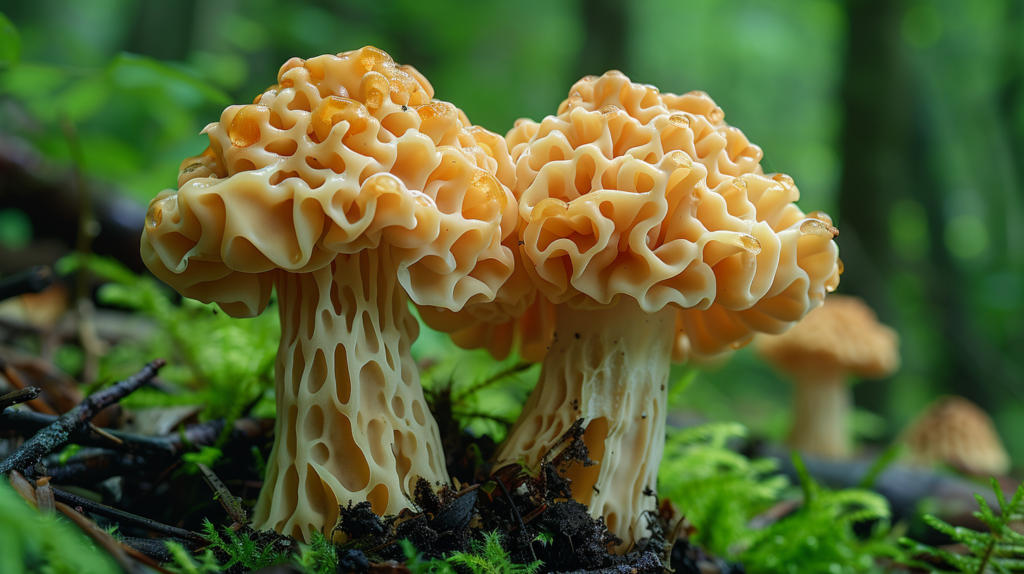
False morels present a unique danger because they’re sometimes confused with edible true morels by foragers. These brain-like mushrooms contain gyromitrin, which converts to rocket fuel component monomethylhydrazine in the digestive system.
Key Identifying Features:
- Cap: 2-4 inches wide, brain-like convoluted surface
- Color: Reddish-brown to dark brown
- Stem: White to pale brown, often hollow
- Shape: Irregular, wrinkled appearance resembling a brain
Toxicity Profile: Gyromitrin toxicity can cause hemolysis (destruction of red blood cells), liver damage, and central nervous system depression. The toxin is heat-stable, meaning cooking doesn’t eliminate the danger.
Clinical Signs:
- Vomiting and bloody diarrhea
- Abdominal pain
- Weakness and lethargy
- Jaundice (yellowing of gums and eyes)
- Difficulty breathing
- Neurological symptoms in severe cases
Safe Mushroom Varieties for Dogs

While many wild mushrooms pose serious risks, certain commercially grown varieties are safe for dogs when prepared properly. Understanding which mushrooms are dog-friendly can help you make informed decisions about sharing your meals with your pet.
Commercial Mushrooms Generally Safe for Dogs
Button Mushrooms (Agaricus bisporus) These common white mushrooms found in grocery stores are safe for dogs in moderation. They’re low in calories and contain beneficial nutrients like potassium, selenium, and B vitamins.
Portobello Mushrooms Mature button mushrooms with opened caps, portobellos are safe for dogs. Their meaty texture makes them appealing to many canines, but they should be served plain without seasonings.
Shiitake Mushrooms Known for their immune-boosting properties in humans, shiitake mushrooms are safe for dogs when cooked. They contain compounds that may support canine immune function.
Oyster Mushrooms These delicate, fan-shaped mushrooms are safe for dogs and provide protein, fiber, and various vitamins. Always cook thoroughly before serving.
Preparation Guidelines for Safe Mushrooms
When offering safe mushrooms to your dog, follow these preparation guidelines:
- Cook thoroughly: Raw mushrooms can be difficult for dogs to digest
- No seasonings: Avoid garlic, onions, salt, or other seasonings toxic to dogs
- Small portions: Introduce gradually to avoid digestive upset
- Plain preparation: Steam, bake, or sauté without oils or butter
- Fresh only: Avoid canned mushrooms with added sodium
Nutritional Benefits of Safe Mushrooms
Safe mushrooms can provide several nutritional benefits for dogs:
| Nutrient | Benefit |
| Protein | Supports muscle development and repair |
| Fiber | Promotes healthy digestion |
| Potassium | Supports heart and muscle function |
| Selenium | Acts as an antioxidant |
| B Vitamins | Support nervous system health |
| Low Calories | Good for weight management |
Recognizing Mushroom Poisoning Symptoms

Early recognition of mushroom poisoning symptoms can mean the difference between successful treatment and tragic outcomes. The clinical presentation varies significantly depending on the type of mushroom consumed, but certain warning signs should always prompt immediate veterinary attention.
Gastrointestinal Symptoms (Most Common Early Signs)
Vomiting
- Often the first symptom to appear
- May contain blood in severe cases
- Can be projectile or persistent
- Usually begins 30 minutes to 6 hours post-ingestion
Diarrhea
- Ranges from loose stools to severe, bloody diarrhea
- May have a foul odor
- Can lead to rapid dehydration
- Often accompanied by abdominal cramping
Abdominal Pain
- Dog may arch their back or assume a prayer position
- Reluctance to move or be touched
- Whimpering or vocalization when abdomen is pressed
- Loss of appetite
Neurological Symptoms (Indicate Severe Toxicity)
Ataxia (Loss of Coordination)
- Stumbling or unsteady gait
- Difficulty standing or walking straight
- Head tilting or circling behavior
- Loss of balance
Seizures
- Can range from mild tremors to full-body convulsions
- May be accompanied by loss of consciousness
- Often indicate severe central nervous system involvement
- Require immediate emergency treatment
Altered Mental State
- Confusion or disorientation
- Excessive lethargy or stupor
- Hyperactivity or agitation
- Loss of response to normal stimuli
Systemic Symptoms (Late-Stage Poisoning)
Jaundice
- Yellowing of the gums, whites of eyes, or inner ear flaps
- Indicates liver damage or failure
- Often accompanied by dark urine
- Poor prognostic sign requiring aggressive treatment
Difficulty Breathing
- Rapid or labored breathing
- Open-mouth breathing at rest
- Blue-tinged gums or tongue (cyanosis)
- May indicate multiple organ involvement
Timeline of Symptom Development
Understanding the typical progression of mushroom poisoning symptoms helps owners recognize the urgency of the situation:
Immediate to 2 Hours:
- Mild gastrointestinal upset with some mushroom types
- Neurological symptoms with psychoactive varieties
2-6 Hours:
- Onset of vomiting and diarrhea with most toxic species
- Abdominal pain becomes apparent
- Dehydration may begin
6-12 Hours:
- Peak gastrointestinal symptoms
- Possible temporary improvement with amatoxin-containing mushrooms
- Neurological symptoms may worsen
12-72 Hours:
- Liver and kidney damage becomes apparent
- Systemic symptoms develop
- Critical period for survival
Immediate Steps When Your Dog Eats Mushrooms
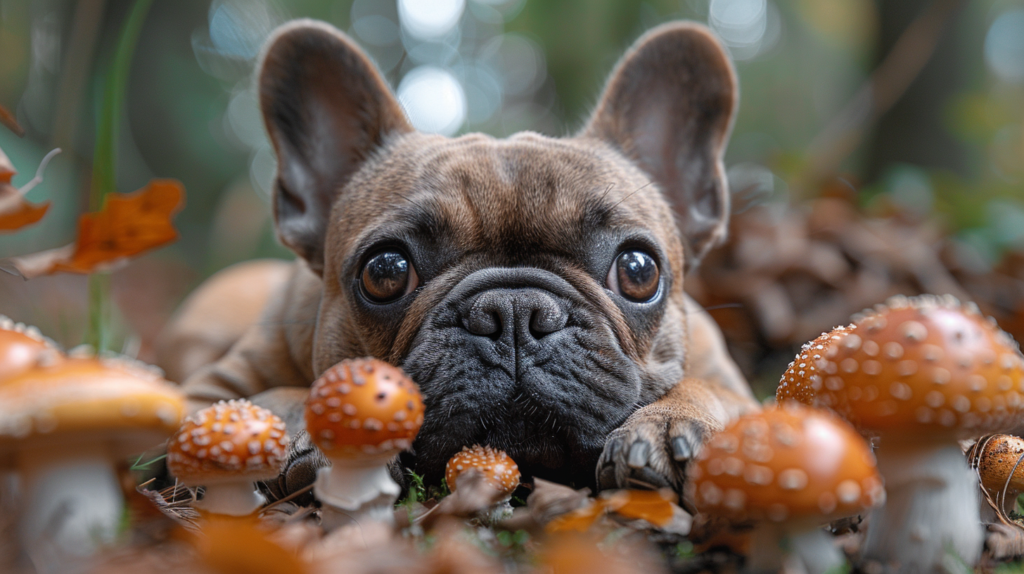
When you discover that your dog has consumed mushrooms, especially wild varieties, every minute counts. Taking swift, appropriate action can significantly improve your pet’s chances of recovery and may prevent serious complications.
Step 1: Stay Calm and Assess the Situation
Don’t Panic Your dog will pick up on your stress, which can worsen their anxiety. Take a deep breath and focus on taking systematic action.
Gather Information
- When did the ingestion occur?
- How many mushrooms were consumed?
- What did the mushrooms look like?
- Is your dog showing any symptoms?
Photograph the Mushrooms If possible, take clear photos of any remaining mushrooms from multiple angles. This will help veterinarians and mycologists identify the species.
Step 2: Contact Emergency Services Immediately
Call Your Veterinarian Contact your regular veterinarian or emergency animal hospital immediately. Even if it’s after hours, most clinics have emergency contact information.
Pet Poison Helpline Call the ASPCA Animal Poison Control Center at (888) 426-4435. They’re available 24/7 and can provide immediate guidance. Note: A consultation fee applies, but the expertise is invaluable.
Provide Detailed Information
- Your dog’s weight, age, and breed
- Time of mushroom consumption
- Description or photos of mushrooms
- Current symptoms
- Any previous health conditions
Step 3: Do NOT Induce Vomiting (Unless Specifically Instructed)
Why Vomiting Can Be Dangerous
- Some mushroom toxins can cause additional damage when vomited back up
- If your dog is already vomiting, inducing more can worsen dehydration
- Aspiration (inhaling vomit) can cause pneumonia
- Only induce vomiting under direct veterinary supervision
Exceptions Your veterinarian may instruct you to induce vomiting if:
- The ingestion was very recent (within 30-60 minutes)
- The dog is alert and not showing symptoms
- You’re too far from veterinary care for immediate treatment
Step 4: Preserve Evidence
Collect Mushroom Samples
- Wrap remaining mushrooms in a paper towel or place in a paper bag
- Include the entire mushroom (cap, stem, base) if possible
- Don’t use plastic bags, as they can accelerate decomposition
- Bring samples to the veterinary clinic
Document Everything
- Time of ingestion
- Symptoms observed and when they started
- Any treatments attempted
- Your dog’s normal behavior for comparison
Step 5: Prepare for Transport
Keep Your Dog Comfortable
- Maintain normal body temperature
- Don’t give food or water unless instructed by a veterinarian
- Monitor breathing and consciousness level
- Be prepared to perform CPR if necessary
Safe Transportation
- Use a carrier or have someone hold your dog securely
- Bring towels in case of vomiting or diarrhea
- Have your veterinarian’s address and phone number readily available
- Ensure someone can navigate while you monitor your pet
Treatment Options and Veterinary Care
Professional veterinary treatment for mushroom poisoning varies significantly based on the type of mushroom consumed, the amount ingested, and how quickly treatment begins. Understanding the treatment process can help you better communicate with your veterinarian and make informed decisions about your dog’s care.
Emergency Stabilization
Initial Assessment Upon arrival at the veterinary clinic, your dog will undergo a rapid triage assessment including:
- Vital signs monitoring (temperature, heart rate, respiratory rate)
- Neurological examination
- Assessment of hydration status
- Blood work to establish baseline organ function
Immediate Interventions
- IV fluid therapy to prevent dehydration and support organ function
- Anti-nausea medications to control vomiting
- Gastroprotectants to protect the stomach lining
- Monitoring equipment for continuous vital sign assessment
Decontamination Procedures
Activated Charcoal If appropriate and administered within 2-4 hours of ingestion, activated charcoal can help absorb remaining toxins in the digestive tract. This treatment is not suitable for all cases and may be contraindicated if the dog is vomiting extensively.
Gastric Lavage In severe cases, veterinarians may perform gastric lavage (stomach pumping) under sedation to remove mushroom particles from the stomach.
Specific Antidotes and Treatments
Milk Thistle (Silymarin) For amatoxin poisoning from death caps or destroying angels, high-dose milk thistle extract may help protect liver cells and promote regeneration. This treatment is most effective when started early.
N-Acetylcysteine This antioxidant can help protect the liver from oxidative damage caused by various mushroom toxins.
Supportive Care
- IV fluid therapy to maintain hydration and electrolyte balance
- Anti-seizure medications if neurological symptoms develop
- Liver protectants and supplements
- Nutritional support if prolonged treatment is required
Advanced Treatment Options
Hemodialysis In cases of severe amatoxin poisoning, some specialty centers offer hemodialysis to help remove toxins from the bloodstream.
Liver Transplantation While extremely rare and expensive, liver transplantation has been performed in cases of severe mushroom poisoning in dogs at specialized veterinary centers.
Monitoring and Prognosis
Laboratory Monitoring
- Complete blood count to monitor for anemia
- Chemistry panels to assess liver and kidney function
- Coagulation studies to check blood clotting ability
- Urinalysis to evaluate kidney function
Recovery Timeline
- Mild cases: 24-48 hours with supportive care
- Moderate cases: 3-7 days of hospitalization
- Severe cases: Weeks of treatment with guarded prognosis
Prevention Strategies for Pet Owners
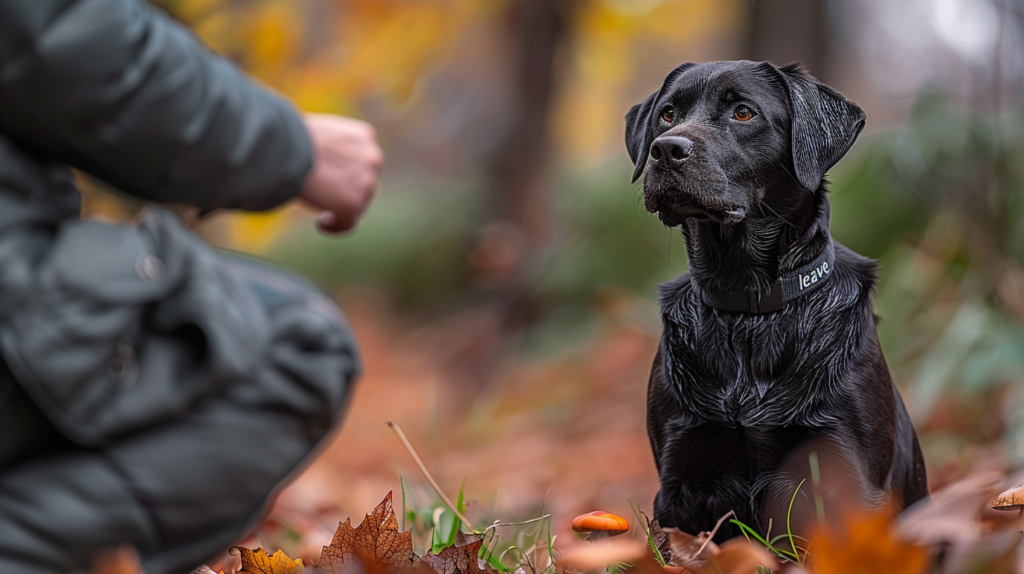
Prevention remains the most effective strategy for protecting your dog from mushroom poisoning. By implementing comprehensive prevention measures, you can significantly reduce the risk of accidental mushroom ingestion and create a safer environment for your furry friend.
Yard Management and Home Safety
Regular Lawn Inspections Conduct thorough weekly inspections of your property, paying special attention to:
- Areas under trees and shrubs
- Mulched garden beds
- Moist, shaded corners
- Areas where organic matter accumulates
- Spots where previous mushrooms have grown
Prompt Mushroom Removal
- Remove mushrooms immediately upon discovery
- Dig up the entire mushroom, including underground portions
- Check the same areas daily during mushroom season
- Dispose of mushrooms in sealed garbage bags
Environmental Modifications
- Improve drainage in persistently damp areas
- Increase sunlight exposure by pruning overhanging branches
- Remove decaying organic matter like fallen leaves and dead plants
- Consider changing mulch types if mushrooms repeatedly appear
Walking and Exercise Safety
Leash Training and Control
- Maintain close control of your dog during walks
- Use a shorter leash in areas known for mushroom growth
- Train the “leave it” command consistently
- Consider using a basket muzzle in high-risk areas during mushroom season
Route Planning
- Avoid walking in heavily wooded areas during peak mushroom seasons (spring and fall)
- Choose well-maintained parks and paths over wild areas
- Vary your walking routes to reduce exposure to specific mushroom populations
- Walk during daylight hours when visibility is better
Seasonal Awareness Different mushroom species appear at various times throughout the year:
- Spring: Morels and false morels emerge
- Summer: Various species proliferate during humid periods
- Fall: Peak season for most dangerous varieties including death caps
- Winter: Generally safer, but some species persist in mild climates
Training Your Dog for Mushroom Avoidance
The “Leave It” Command This essential command can be lifesaving:
- Start with treats in your closed fist
- Say “leave it” and wait for your dog to stop trying to get the treat
- Reward when they back away or look at you
- Gradually increase difficulty by using more tempting items
- Practice regularly with various objects, including mushrooms when safe
Positive Reinforcement Training
- Reward your dog for ignoring mushrooms during walks
- Use high-value treats to redirect attention away from fungi
- Practice recall commands regularly to ensure reliable response
- Consider professional training if your dog has strong scavenging tendencies
Creating a Mushroom-Safe Environment
Landscaping Considerations
- Choose plants and ground covers that don’t support mushroom growth
- Install proper drainage systems to reduce moisture
- Use inorganic mulches like gravel or rubber in high-risk areas
- Consider raised planters to keep organic matter away from ground level
Pet Area Design
- Create designated play areas with mushroom-resistant surfaces
- Install fencing to separate dogs from wild or wooded areas
- Provide adequate shade and shelter without creating mushroom-friendly microclimates
- Use concrete, artificial turf, or gravel in high-use areas
When to Seek Emergency Veterinary Care
Understanding when mushroom ingestion constitutes a true emergency versus a situation that requires monitoring can help you make life-saving decisions for your pet. While any mushroom consumption by dogs warrants attention, certain circumstances demand immediate professional intervention.
Red Flag Symptoms Requiring Immediate Care
Severe Gastrointestinal Distress
- Projectile or bloody vomiting
- Severe diarrhea with blood or mucus
- Signs of severe abdominal pain (hunched posture, crying when touched)
- Inability to keep water down
Neurological Warning Signs
- Seizures or convulsions of any severity
- Loss of consciousness or unresponsiveness
- Severe loss of coordination or collapse
- Abnormal behavior such as aggression or extreme confusion
Systemic Symptoms
- Difficulty breathing or rapid, shallow breathing
- Pale or blue-tinged gums
- Weakness or inability to stand
- Yellowing of the gums or whites of the eyes
Time-Sensitive Situations
Recent Ingestion of Unknown Mushrooms If your dog consumed wild mushrooms within the past 2-4 hours, immediate veterinary care offers the best chance for successful decontamination and treatment initiation.
Known Consumption of Dangerous Species Any ingestion of identified toxic species like death caps, destroying angels, or fly agaric requires emergency treatment regardless of whether symptoms have appeared.
Multiple Mushroom Consumption Dogs that have eaten several mushrooms face a higher toxin load and increased risk of severe poisoning.
Geographic Risk Assessment
High-Risk Regions Certain geographic areas have higher concentrations of deadly mushroom species:
- Pacific Northwest (death caps, destroying angels)
- Great Lakes region (false morels, various Amanita species)
- Southeastern United States (destroying angels, various toxic species)
- California (death caps, especially in oak woodlands)
Seasonal Considerations Emergency risk increases during peak mushroom seasons:
- Spring: March through May in most regions
- Fall: September through November, peak danger period
- After rainfall: Increased mushroom emergence 48-72 hours post-precipitation
Decision-Making Framework
Always Seek Immediate Care If:
- Your dog consumed any wild mushroom
- Symptoms are present, regardless of severity
- You’re unsure about mushroom identification
- Your dog has underlying health conditions
- Multiple dogs were exposed
Monitor Closely and Call for Guidance If:
- Your dog ate a small amount of commercial mushroom
- No symptoms are present after known safe mushroom consumption
- You can definitively identify consumed mushrooms as non-toxic varieties
Long-term Health Considerations
Mushroom poisoning can have lasting effects on your dog’s health, particularly when severe toxicity affects major organ systems. Understanding potential long-term consequences and implementing appropriate follow-up care is crucial for maintaining your pet’s quality of life after a mushroom poisoning incident.
Liver Health Monitoring
Chronic Liver Damage Dogs that survive severe amatoxin poisoning may develop chronic liver disease requiring lifelong management:
- Regular blood chemistry panels to monitor liver enzymes
- Dietary modifications to reduce liver workload
- Hepatoprotective supplements like milk thistle
- Careful medication selection to avoid additional liver stress
Liver Function Assessment Post-poisoning liver monitoring typically includes:
- Alanine aminotransferase (ALT) levels
- Alkaline phosphatase (ALP) measurements
- Bilirubin concentrations
- Albumin and total protein levels
- Bile acid testing for functional assessment
Kidney Function Implications
Renal Damage from Toxins Some mushroom toxins can cause permanent kidney damage:
- Reduced filtration capacity requiring dietary protein modification
- Increased susceptibility to dehydration
- Need for regular urinalysis and blood urea nitrogen monitoring
- Potential requirement for prescription kidney diets
Neurological Sequelae
Persistent Neurological Effects Dogs experiencing severe neurological symptoms during poisoning may develop:
- Chronic seizure disorders requiring anti-convulsant medication
- Persistent coordination problems
- Behavioral changes or cognitive dysfunction
- Increased sensitivity to stress or environmental changes
Nutritional and Dietary Management
Post-Recovery Nutrition Dogs recovering from mushroom poisoning benefit from:
- Easily digestible, high-quality proteins
- Reduced sodium intake to support kidney and liver function
- Antioxidant-rich foods to support cellular repair
- Smaller, more frequent meals to reduce digestive stress
Supplement Considerations Veterinarians may recommend:
- Probiotics to restore healthy gut bacteria
- Omega-3 fatty acids for anti-inflammatory effects
- Vitamin E and selenium for antioxidant support
- B-complex vitamins to support liver function
Can Dogs Have Mushrooms (FAQ)
What should I do if my dog ate a mushroom from my yard?
If your dog consumed any mushroom from your yard, contact your veterinarian or pet poison control immediately, even if the dog appears normal. Take photos of any remaining mushrooms and bring samples to your vet for identification. Wild mushrooms can be extremely dangerous, and early intervention significantly improves outcomes. Don’t wait for symptoms to appear, as some toxic mushrooms cause delayed reactions after irreversible damage has occurred.
How quickly do mushroom poisoning symptoms appear in dogs?
Mushroom poisoning symptoms can appear anywhere from 30 minutes to 12 hours after ingestion, depending on the species consumed. Gastrointestinal symptoms like vomiting and diarrhea typically appear first, within 30 minutes to 6 hours. However, the most dangerous mushrooms containing amatoxins may not cause symptoms for 6-12 hours, during which time significant organ damage occurs. This delayed onset makes immediate veterinary care crucial regardless of whether symptoms are present.
Can dogs eat store-bought mushrooms safely?
Dogs can eat certain store-bought mushrooms in small quantities when prepared properly. Safe varieties include plain, cooked button mushrooms, portobello, shiitake, and oyster mushrooms. However, they should be served without seasonings, oils, or spices that could be harmful to dogs. Introduce mushrooms gradually and in moderation, as some dogs may experience digestive upset. Never give dogs raw mushrooms or any seasoned mushroom dishes intended for human consumption.
Are there any home remedies for mushroom poisoning in dogs?
There are no safe or effective home remedies for mushroom poisoning in dogs. Do not attempt to induce vomiting, give activated charcoal, or use any home treatments without explicit veterinary guidance. These actions can potentially worsen the situation or mask important symptoms. The only appropriate response to suspected mushroom poisoning is immediate professional veterinary care. Time is critical, and delays in proper treatment can result in permanent organ damage or death.
How can I train my dog to avoid mushrooms during walks?
Train your dog to avoid mushrooms using the “leave it” command combined with positive reinforcement. Start training with treats, rewarding your dog for ignoring items when commanded. Practice regularly with various objects, gradually including safe mushroom props during training sessions. Keep your dog on a leash during walks, especially in wooded areas during mushroom season. Reward good behavior when your dog ignores mushrooms naturally, and redirect their attention with high-value treats when necessary.
What’s the survival rate for dogs with mushroom poisoning?
Survival rates for mushroom poisoning in dogs vary dramatically based on the species consumed, amount ingested, and speed of treatment. Dogs consuming non-toxic or mildly toxic mushrooms typically recover fully with supportive care. However, poisoning from highly toxic species like death caps can have mortality rates of 50-90% even with aggressive treatment. Early intervention within the first few hours of ingestion significantly improves survival odds, emphasizing the importance of immediate veterinary care for any suspected mushroom consumption.
For more expert pet care tips and product recommendations, visit BlithePet.com your trusted source for pet wellness.
Conclusion
Understanding whether dogs can have mushrooms is a critical aspect of responsible pet ownership that could save your furry friend’s life. While certain commercial mushrooms can be safe treats when prepared properly, wild mushrooms pose a significant and potentially fatal threat to our canine companions.
The four most dangerous mushroom types—death caps, destroying angels, fly agaric, and false morels—contain toxins that can cause irreversible organ damage and death within hours of consumption. Recognition of poisoning symptoms, immediate emergency response, and rapid veterinary intervention are the keys to successful treatment outcomes.
Prevention remains your best defense against mushroom poisoning. Regular yard maintenance, proper leash control during walks, and training your dog to avoid unknown objects can dramatically reduce exposure risks. Remember that no amount of mushroom identification knowledge replaces the need for immediate veterinary care when consumption occurs.
The statistics speak clearly: mushroom poisoning cases are increasing as urban development encroaches on natural habitats, bringing dangerous fungi closer to our homes and walking paths. By staying informed, maintaining vigilance, and acting quickly when incidents occur, you can protect your beloved pet from this hidden danger lurking in our everyday environment.
Have a similar experience with your pet? Share it in the comments below to help other dog owners learn from your story!

